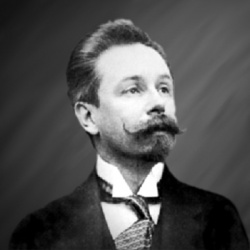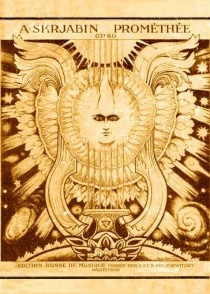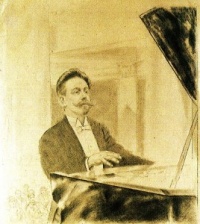Alexander Scriabin: Difference between revisions
No edit summary |
No edit summary |
||
| Line 15: | Line 15: | ||
== Theosophical Society connections == | == Theosophical Society connections == | ||
[[File:Prometheus Symphony art.jpg|right| | [[File:Prometheus Symphony art.jpg|right|210px|right|thumb|Cover by Jean Delville for ''Prometheus'' symphony]] | ||
A young friend the Viscount de Gissac asked Scriabin to lecture and write in French, but the composer declined, claiming that his knowledge of French was insufficient. Studying Theosophical literature in French improved his proficiency, so that eventually Scriabin used French notation in his musical compositions. | |||
<blockquote> | <blockquote> | ||
In Paris in early 1905, de Gissac gave Scriabin a copy of ''La Clef de la Théosophie'', the French translation of [[Helena Petrovna Blavatsky|Helena Blavatsky’s]] book [[The Key to Theosophy (book)|''The Key to Theosophy'']] (1889) which Scriabin described in a letter of April/May 1905 as a remarkable book and astonishingly close to his own thinking. From that time on, more and more of Scriabin’s circle of friends were drawn from the French and Belgian branches of the [[Theosophical Society (Adyar)||Theosophical Society]], most notably the painter [[Jean Delville]] with whom Scriabin became associated when he relocated to Brussels in 1908. It has been suggested that Scriabin enrolled into formal membership of its Belgian branch at this time, and that Delville may have introduced him to the Sons of the Flames of Wisdom, a secret Promethean cult within Theosophy, but solid documentary evidence for this has yet be produced. Both Leonid Sabaneev and Boris Schloezer later recalled that a French translation of Blavatsky’s book [[The Secret Doctrine (book)|''The Secret Doctrine'']] (1888) was always on Scriabin’s work table. It was clear that Scriabin had studied ''La Doctrine Secrète'' with great care as he had annotated and underlined in pencil what he considered to be the most important passages. Scriabin also subscribed to [[Le Lotus Bleu (periodical)|''Le Lotus Bleu'']], a monthly francophone theosophical journal, during the period 1904–9 inclusive; this observation can help to account for the presence of the expressive French musical directions in ''Le Divin Poème'', Op.43 (1904). Taken altogether, it is clear that Scriabin carefully studied a very considerable amount of theosophical literature in French during 1904–1909 while he was resident outside Russia, and this would undoubtedly have improved his capacity to express his esoteric, occultist and mystical intentions for his music. | |||
... In addition to the two French texts by Blavatsky and the monthly copies of ''Le Lotus Bleu'' mentioned above, Scriabin also had French translations of Auguste Barth’s ''The Religions of India'' and [[Edwin Arnold|Edwin Arnold’s]] [[The Light of Asia (book)|''The Light of Asia'']] in his bookcase. Furthermore, from 1911 onwards in Moscow Scriabin subscribed to three theosophical journals including the francophone monthly periodical ''Revue Théosophique Belge''.<ref>Richard E. Overill, ''Alexander Scriabin’s Use of French Directions to the Pianist'' at [http://www.scriabin-association.com/articles/alexander-scriabins-use-of-french-directions-to-the-pianist/ Scriabin Association web page].</ref> | |||
</blockquote> | </blockquote> | ||
< | |||
< | Scriabin began to blend together Theosophical concepts with the native symbolism of the Russian Silver Age artists and writers as he wrote expressive directions for works such as the ''Preparatory Act'' of the ''Mysterium''.<ref>Ibid.</ref> | ||
< | |||
< | [[Jean Delville]], the Belgian artist whom he met in 1908, became his friend. Delville, a dedicated Theosophist, designed the cover for the score to Scriabin's ''Prometheus'' symphony. | ||
<blockquote> | |||
He adored the cover design of his ''Promotheus'' symphony. It showed a sexless face surrounded by cosmic symbols, nebulae of clouds, spiraling comets, and was drawn by his Belgian friend, [[Jean Delville ]](b. 1867), a bachelor, professor of Fine Arts at the Royal Academy, and President of the national Federation of Artists and Sculptors. Looking at that cover of the androgyne or hermaphrodite, Scriabin said, "In those ancient races, male and female were one… the separation into poles hadn't yet taken place.<ref>Faubion Bowers, ''Scriabin: A Biography of the Russian Composer 1871-1915, Volume I'' (Tokyo:Kodansha International Ltd, 1969), 87.</ref> | |||
</blockquote> | |||
== Later years == | == Later years == | ||
[[File:Alexander Scriabin at piano.jpg|left|200px|thumb|Scriabin at his last recital. By B. Kustodiev]] | [[File:Alexander Scriabin at piano.jpg|left|200px|thumb|Scriabin at his last recital. By B. Kustodiev]] | ||
Revision as of 02:39, 14 October 2016
Alexander Nikolayevich Scriabin was a Russian pianist and composer who was much influenced by Theosophy.
Early life and education
Musical career
Theosophical Society connections
A young friend the Viscount de Gissac asked Scriabin to lecture and write in French, but the composer declined, claiming that his knowledge of French was insufficient. Studying Theosophical literature in French improved his proficiency, so that eventually Scriabin used French notation in his musical compositions.
In Paris in early 1905, de Gissac gave Scriabin a copy of La Clef de la Théosophie, the French translation of Helena Blavatsky’s book The Key to Theosophy (1889) which Scriabin described in a letter of April/May 1905 as a remarkable book and astonishingly close to his own thinking. From that time on, more and more of Scriabin’s circle of friends were drawn from the French and Belgian branches of the |Theosophical Society, most notably the painter Jean Delville with whom Scriabin became associated when he relocated to Brussels in 1908. It has been suggested that Scriabin enrolled into formal membership of its Belgian branch at this time, and that Delville may have introduced him to the Sons of the Flames of Wisdom, a secret Promethean cult within Theosophy, but solid documentary evidence for this has yet be produced. Both Leonid Sabaneev and Boris Schloezer later recalled that a French translation of Blavatsky’s book The Secret Doctrine (1888) was always on Scriabin’s work table. It was clear that Scriabin had studied La Doctrine Secrète with great care as he had annotated and underlined in pencil what he considered to be the most important passages. Scriabin also subscribed to Le Lotus Bleu, a monthly francophone theosophical journal, during the period 1904–9 inclusive; this observation can help to account for the presence of the expressive French musical directions in Le Divin Poème, Op.43 (1904). Taken altogether, it is clear that Scriabin carefully studied a very considerable amount of theosophical literature in French during 1904–1909 while he was resident outside Russia, and this would undoubtedly have improved his capacity to express his esoteric, occultist and mystical intentions for his music.
... In addition to the two French texts by Blavatsky and the monthly copies of Le Lotus Bleu mentioned above, Scriabin also had French translations of Auguste Barth’s The Religions of India and Edwin Arnold’s The Light of Asia in his bookcase. Furthermore, from 1911 onwards in Moscow Scriabin subscribed to three theosophical journals including the francophone monthly periodical Revue Théosophique Belge.[1]
Scriabin began to blend together Theosophical concepts with the native symbolism of the Russian Silver Age artists and writers as he wrote expressive directions for works such as the Preparatory Act of the Mysterium.[2]
Jean Delville, the Belgian artist whom he met in 1908, became his friend. Delville, a dedicated Theosophist, designed the cover for the score to Scriabin's Prometheus symphony.
He adored the cover design of his Promotheus symphony. It showed a sexless face surrounded by cosmic symbols, nebulae of clouds, spiraling comets, and was drawn by his Belgian friend, Jean Delville (b. 1867), a bachelor, professor of Fine Arts at the Royal Academy, and President of the national Federation of Artists and Sculptors. Looking at that cover of the androgyne or hermaphrodite, Scriabin said, "In those ancient races, male and female were one… the separation into poles hadn't yet taken place.[3]
Later years
On April 2, 1915, Scriabin performed his final recital in St. Petersburg.
Musical compositions
Theosophist Margaret Cousins, a concert pianist, wrote: "His music has constantly in it a most poignant sweet quality which seems to pierce to the holy of holies of one's being."[4]
Scriabin Museum
The Alexander Scriabin Memorial Museum was established on July 17, 1922 to preserve the apartment where the composer lived for his final three years, in an old mansion on Arbat Street in Moscow. The composer's prized possessions were carefully restored, including his copy of The Secret Doctrine.[5] The museum preserves Scriabin's library, letters, sheet music, and other items.
Additional resources
The Union Index of Theosophical Periodicals lists articles about Scriabin.
Notes
- ↑ Richard E. Overill, Alexander Scriabin’s Use of French Directions to the Pianist at Scriabin Association web page.
- ↑ Ibid.
- ↑ Faubion Bowers, Scriabin: A Biography of the Russian Composer 1871-1915, Volume I (Tokyo:Kodansha International Ltd, 1969), 87.
- ↑ Margaret Cousins, "Memorabilia of Scriabine - the Master Musician of Theosophy," The Theosophist 56 (November 134), 173.
- ↑ Faubion Bowers, Scriabin: A Biography of the Russian Composer 1871-1915, Volume I (Tokyo:Kodansha International Ltd, 1969), 87.


